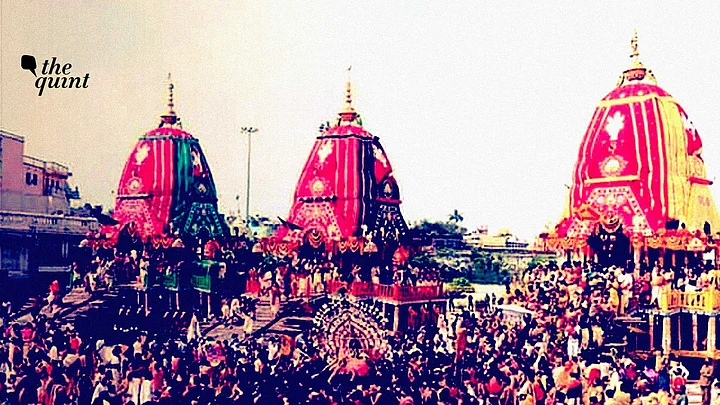The famous Rath Yatra of Puri is progressing as scheduled. It is for a record second time, that the festival is being conducted without devotees. Slightly ironic as for centuries, Lord Jagannath of Puri has been known as ‘Bhakta Bastala’ (He who loves His devotees).
However, the pandemic has drawn a line between Him and millions of His devotees, who till now would only have seen a glimpse of the deities through a small television screen. when on their
Across the world, devotees this year, will be deprived of the physical ‘darshan’ of their Lord, seated on majestic chariots. There will be no more singing of hymns by devotees, renting the air through the three kilometre journey lasting over three hours for a nine-day visit to their birth place, the Sri Gundicha temple.
As per the traditions and rituals, people from some communities are barred from entering the temple. This practice appears contrary to the spirit of universality that is defined by the Lord of Puri (Shri Krishna). The Yatra, on the other hand, is a manifestation of the universal love and devotion that surrounds the deities.
Why Do The Chariots Halt At A Mazar?
When the chariots roll down about 200 metres on Grand Road (or Bada Danda), the Nandighosh (chariot of Lord Jagannath) comes to a screeching halt before a mazar (tomb) on the right side.
After a brief stop and a few moments spent in remembrance of the soul resting in peace inside the tomb, the chariot proceeds towards the destination.
This ritual of the deity's halt has a fascinating tale behind it.
It dates back to centuries ago—during the Mughal reign.
Jahangir Quli Khan, also known as Lalbeg, was the Subedar of Bengal for one year (1607-1608) during the reign of Jahangir, the Mughal emperor. During one of his military excursions in Odisha, he came across a young widowed Brahmin lady returning from her bath. She immediately caught his fancy with her beauty. Although he took the lady forcibly on his horse back, they eventually fell in love, got married, and he gave her complete freedom to pursue her faith.
A son was born to them whom they named Salabeg. Growing up close to his mother, Salabeg had an early initiation to the cult of Lord Jagannath as his mother was an ardent devotee.
Muslim Devotee of Lord Jagannath, Denied Entry to the Temple
It did not take long for the young Salabeg, a Muslim brought up under the paternal shade of the Mughal Army to develop deep devotion in Lord Jagannath. His tale of devotion is still alive in the innumerable bhajans (hymns) and songs that have claimed a place in the repertoires of the Lord’s rituals.
But, Salabeg was deeply sorrowful about not being able to pay his respects to his Lord in his own temple because of his community. He is said to have spent at least a year in Vrindavan, devoted to his God, Shri Krishna.
The legend has it that Salabeg fell sick while he was returning to Odisha to be able to attend the Yatra. When his body almost gave up, he prayed to Lord Jagannath to allow him at least one darshan. Scores of bhajans and songs in praise of the Lord were a combination of Salabeg's unflinching faith and patience.
The voice of his soul stirred Lord Jagannath. When the Yatra began, the chariot came to a sudden halt in front of Salabeg's hut and didn't move. That was believed to be the inner voice of Salabeg, which got divine sanction to halt. Lord Jagannath, thus, allowed his staunch devotee to come and worship in person, from below the chariot.
It was only after Salabeg had paid his respects that the chariot moved ahead.
The same tradition is followed to this date. The Lord’s chariot has to make a mandatory stop at his devotee's tomb.
Salabeg's Place in Bhakti Poetry
Salabeg’s bhajan, ‘Ahe Neelashaila” (Oh Bluestone Lord..) remains an all-time hit in the annals of the Lord’s rituals to this day. Dr. Mohammed Yamin writes the following in Odisha Review:
Intoxicated with ‘Krishnarasa’ Salabeg must have desired to go to Brindavan. There he might have heard about the dalliances of his presiding deity from the saints and seers of the place and greatly lost in the Bala Mukunda form of Sri Krishna. The child like behavior of Sri Krishna towards his mother must have fascinated Salbeg, therefore, he composed a few Chaupadis describing the amusements of that child Sri Krishna.In the composition of a poem Sunapua Nachaire Salbeg described the problem created by child Krishna to mother Yasoda while taking his foods. The affectionate mother Yasoda feeds the Krishna by reciting a few songs.
Critics like Sundarananda Vidyavinod and Sukumar Sen recognise Salabeg as an established Bhakti poet of 17th century Odisha and accord due respect to his Vaishnavite verses written in Hindi, Bengali and Odia.
(Dinendra Narayan Singh is a Bhubaneswar-based senior journalist and political analyst. This is a report and analysis. The views expressed are the author’s own. The Quint neither endorses nor is responsible for them.)
